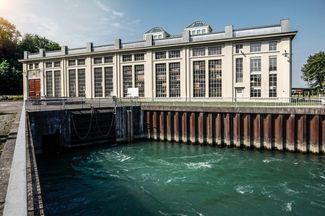Hitherto there has been no political concept for guaranteeing reliability of supply in Switzerland in the future. The Federal Council is addressing this issue as part of the revision of the Electricity Supply Act. It is focusing here on capacity mechanisms, an area in which BKW has been involved for many years. This will create targeted investment incentives as well as the basis for short- and long-term supply stability.
Market-based instruments for ensuring reliability of supply
Low electricity prices, the phasing out of nuclear power, increasing investment demands for hydroelectric power, and the increasing uncertainty with regard to imports from Germany and France all present a growing challenge to the reliability of supply in Switzerland. Hitherto there has been no adequate concept for guaranteeing reliability of supply in future. We therefore welcome the fact that, as part of the revision of the Electricity Supply Act, the Federal Council is providing additional, market-based instruments for the short- and long-term security of the electricity supply in the form of storage reserves and the option of tendering new (winter) production capacities.

Additional market for reliability of supply
The Federal Council’s proposal largely corresponds with the model for supply reliability presented by BKW in 2017. This model is based on what is known as a “capacity market”. This refers to an additional market for reliability of supply, where a central authority defines the necessary power plant capacity and tenders this centrally. A capacity market would create targeted investment incentives and a basis for short- and long-term supply stability.
Security through a networked Europe
Limited access to the European energy market can also lead to supply shortages in Switzerland. Against this backdrop, Switzerland should conclude a corresponding electricity agreement with the EU as quickly as possible. The prerequisites for doing so are the complete liberalisation of the electricity market as well as an agreement between Switzerland and the EU regarding the further development of bilateral relations.

Frequently asked questions
At first glance, it’s solid. Switzerland has gross power plant capacity of around 22 gigawatts (GW), while maximum demand is around 10 GW. But most of this involves storage systems. Whether it is actually available depends to a large extent on the water level of the reservoirs. In the medium and long term, there is also the question of whether domestic electricity production is sufficient to guarantee reliability of supply. On the one hand, Swiss nuclear power plants are gradually being removed from the grid and will be replaced as part of the Energy Strategy 2050, mainly by renewable energies. These sources make less of a contribution to the supply during winter. On the other hand, hydroelectric power plants need increased reinvestments in order to continue operating.
As a result, critical supply situations can occur in Switzerland, particularly towards the end of winter when reservoirs are largely empty and neighbouring countries are only able to export small to very limited amounts of electricity. Over the coming years, Germany and France will continue to be net exporters of electricity, but especially in critical periods during winter when there is high demand and little photovoltaic and wind power production, they will have to limit their deliveries to neighbouring countries and may even be forced to import electricity themselves. This is because renewable energies will continue to be expanded in these two countries, while conventional power plants that can be controlled will increasingly be deactivated. Germany will remove its last nuclear power plant from the grid by the end of 2022 and gradually deactivate all of its coal power plants by 2038 at the latest. Production from nuclear power plants is declining in France as well.
Because almost no-one is investing in new large-scale power plants under the current market conditions. While electricity prices have recovered somewhat from their low in 2016, a further increase is limited due to the continued strong increase in solar and wind energy in Europe. The current and likely future price levels in the electricity market do not provide sufficient investment incentives – either for increasingly necessary reinvestments in hydroelectric power or for new storage power plants, or for potentially necessary construction of backup power plants to ensure reliability of supply.
First, the necessary power plant capacity to cover electricity needs in winter would be defined (self-sufficiency level). The required amount of electricity would be tendered on the capacity market. Here, two different auction mechanisms would be used:
- The forward capacity auction is the core element and creates incentives to maintain and expand power plant capacity that can produce energy during the winter months. As part of an auction held four years in advance, a central authority will procure power plant capacity for the winter months. As a result of this lead time, both existing as well as new and refurbished systems will be able to participate. If the available power plants do not meet the needs and the energy market alone does not create sufficient investment incentives, the auction will set a price for new and refurbished or expanded power plant capacity. This will result in an incentive for (re)investments in power plants that contribute to the reliability of supply during the winter months.
- The availability auction which takes place six months in advance is a complement to ensure that power plants and storage facilities are also available at the end of winter. Specifically, this involves a tendered “product” for the continuous production capacity of a power plant over a certain period of time – e.g. at least 10 days in April. Because only existing systems would be able to participate due to the short notice, the price during the auction would be determined on the basis of the opportunity costs of retaining the storage.
Capacity markets have several advantages compared to other market models:
- Real contribution to reliability of supply: The model not only promotes the expansion of the power plant portfolio, it also provides answers to the most pressing challenges facing Switzerland: reliability of supply during winter, with a special focus on the critical months towards the end of winter.
- Flexible market mechanism: The model is based on a market mechanism. As a result, the most efficient technologies for a secure supply are promoted and dead weight effects are minimised. This is because those power plants that make a significant contribution to reliability of supply in winter will have the best prospects. In addition, capacity markets respond to trends in electricity prices. If prices rise, the market offers sufficient (re)investment incentives and auction prices tend towards zero. In other words, money is only paid out when it is necessary to ensure reliability of supply.
- EU-compatible: A capacity market is compatible with the EU domestic market and can therefore be maintained after the conclusion of an electricity agreement. It works both in the current partially liberalised market and also when there is complete liberalisation. Both increase investment security.
- Backup power plant: If necessary, a capacity market can also be used to finance a reserve power plant. Such a plant would only operate for a few hours, but it would provide important insurance for the system as a whole.
Yes. Countries have introduced capacity mechanisms as a complement to the energy market since the first wave of liberalisations in the 1990s in order to create investment incentives and thus long-term reliability of supply. Such models now exist, for example, in the USA, the UK and more recently in France and Italy as well.